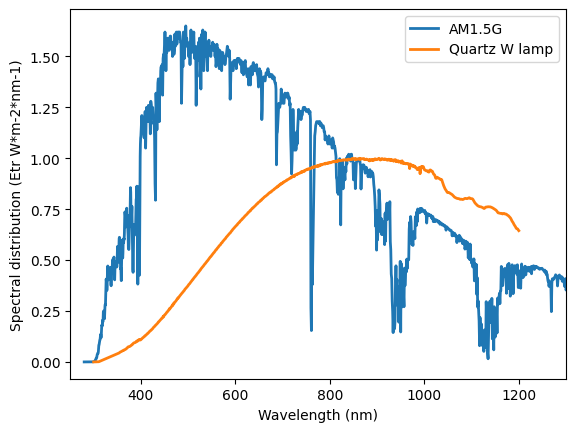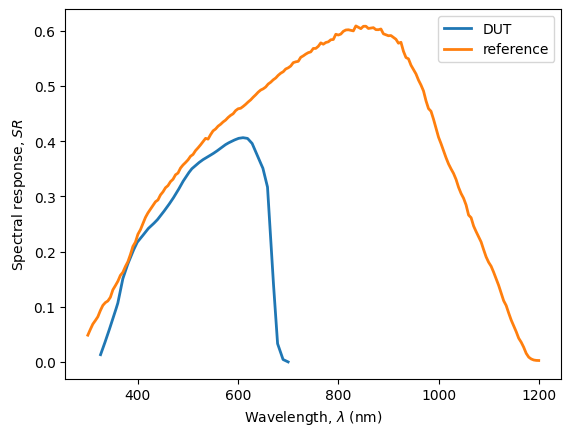Problem 12.9#
Fundamentals of Solar Cells and Photovoltaic Systems Engineering
Solutions Manual - Chapter 12
Problem 12.9
When the spectral response of the reference cell is different from the cell under test and/or the spectrum of the simulator lamp is different from the reference spectrum, the spectral mismatch factor \(M_f\) can be used to correct the measurement. In this problem, the QE of a GaInP cell (device under test) and a calibrated Si solar cell (reference cell) are provided. Calculate their respective SR and estimate the corresponding spectral mismatch factor, when the test cell is measured using a quartz tungsten halogen lamp, relative to the reference spectrum AM1.5 G.
We will use the package pandas to handle the data and matplotlib.pyplot to plot the results.
import pandas as pd
import numpy as np
import matplotlib.pyplot as plt
We start by importing the data for the solar spectra.
reference = pd.read_csv('data/Reference_spectrum_ASTM-G173-03.csv', index_col=0, header=0)
reference
| AM0 | AM1.5G | AM1.5D | |
|---|---|---|---|
| Wvlgth nm | Etr W*m-2*nm-1 | Global tilt W*m-2*nm-1 | Direct+circumsolar W*m-2*nm-1 |
| 280 | 8.20E-02 | 4.73E-23 | 2.54E-26 |
| 280.5 | 9.90E-02 | 1.23E-21 | 1.09E-24 |
| 281 | 1.50E-01 | 5.69E-21 | 6.13E-24 |
| 281.5 | 2.12E-01 | 1.57E-19 | 2.75E-22 |
| ... | ... | ... | ... |
| 3980 | 8.84E-03 | 7.39E-03 | 7.40E-03 |
| 3985 | 8.80E-03 | 7.43E-03 | 7.45E-03 |
| 3990 | 8.78E-03 | 7.37E-03 | 7.39E-03 |
| 3995 | 8.70E-03 | 7.21E-03 | 7.23E-03 |
| 4000 | 8.68E-03 | 7.10E-03 | 7.12E-03 |
2003 rows × 3 columns
reference.drop(reference.index[0], inplace=True) # remove row including information on units
reference=reference.astype(float) # convert values to float for easy operation
reference.index=reference.index.astype(float) # convert indexes to float for easy operation
We import the data for the quartz tungsten halogen lamp.
quartz_w = pd.read_csv('data/W lamp spectral irradiance.csv', index_col=0, header=0)
quartz_w
| W halogen lamp (W*m-2*nm-1) | |
|---|---|
| wavelength (nm) | |
| 300 | 0.000001 |
| 301 | 0.000010 |
| 302 | 0.000100 |
| 303 | 0.000200 |
| 304 | 0.000300 |
| ... | ... |
| 1196 | 0.654304 |
| 1197 | 0.653941 |
| 1198 | 0.651544 |
| 1199 | 0.647531 |
| 1200 | 0.644677 |
901 rows × 1 columns
We can also plot the AM1.5G spectra and the quartz tungsten halogen lamp spectra.
plt.plot(reference['AM1.5G'],
linewidth=2, label='AM1.5G')
plt.plot(quartz_w['W halogen lamp (W*m-2*nm-1)'],
linewidth=2, label='Quartz W lamp')
plt.ylabel('Spectral distribution (Etr W*m-2*nm-1)')
plt.xlabel('Wavelength (nm)')
plt.xlim([250,1300])
plt.legend()
<matplotlib.legend.Legend at 0x7fd2409e77d0>

We define the relevant constants and retrieve the QE of the GaInP solar cell (device under test), and the callibrated Silicon solar cell (reference cell).
h=6.63*10**(-34) # [J·s] Planck constant
e=1.60*10**(-19) # [C] electron charge
c =299792458 #[m/s] Light speed
QE_dut = pd.read_csv('data/QE_GaInP.csv', index_col=0, header=0)
QE_cal= pd.read_csv('data/QE_calibrated_cell.csv', index_col=0, header=0)
We calculate the Spectral Response (SR) of both cells and plot them.
SR_dut=pd.Series(index=QE_dut.index,
data=[QE_dut.loc[i,'QE']*e*i*0.000000001/(h*c) for i in QE_dut.index])
SR_cal=pd.Series(index=QE_cal.index,
data=[QE_cal.loc[i,'QE']*e*i*0.000000001/(h*c) for i in QE_cal.index])
plt.plot(SR_dut,
linewidth=2,
label='DUT')
plt.plot(SR_cal,
linewidth=2,
label='reference')
plt.legend()
plt.ylabel('Spectral response, $SR$')
plt.xlabel(r'Wavelength, $\lambda$ (nm)');

For every spectra and solar cell, we interpolate the spectrum at those datapoints included in the SR, and integrate to obtain the short-circuit current density using Eq. 3.5.
\(J_{L, spectrum, cell}=\int SR(\lambda) \cdot G(\lambda) \ d\lambda\)
spectra=quartz_w['W halogen lamp (W*m-2*nm-1)']
spectra_interpolated=np.interp(SR_dut.index, spectra.index, spectra.values)
J_sim_dut = np.trapz([x*y for x,y in zip(SR_dut, spectra_interpolated)], x=SR_dut.index)*1000/10000 # A-> mA ; m2 -> cm2
spectra_interpolated=np.interp(SR_cal.index, spectra.index, spectra.values)
J_sim_cal = np.trapz([x*y for x,y in zip(SR_cal, spectra_interpolated)], x=SR_cal.index)*1000/10000 # A-> mA ; m2 -> cm2
spectra=reference['AM1.5G']
spectra_interpolated=np.interp(SR_dut.index, spectra.index, spectra.values)
J_ref_dut =np.trapz([x*y for x,y in zip(SR_dut, spectra_interpolated)], x=SR_dut.index)*1000/10000 # A-> mA ; m2 -> cm2
spectra_interpolated=np.interp(SR_cal.index, spectra.index, spectra.values)
J_ref_cal =np.trapz([x*y for x,y in zip(SR_cal, spectra_interpolated)], x=SR_cal.index)*1000/10000 # A-> mA ; m2 -> cm2
/tmp/ipykernel_3468/1724697503.py:3: DeprecationWarning: `trapz` is deprecated. Use `trapezoid` instead, or one of the numerical integration functions in `scipy.integrate`.
J_sim_dut = np.trapz([x*y for x,y in zip(SR_dut, spectra_interpolated)], x=SR_dut.index)*1000/10000 # A-> mA ; m2 -> cm2
/tmp/ipykernel_3468/1724697503.py:5: DeprecationWarning: `trapz` is deprecated. Use `trapezoid` instead, or one of the numerical integration functions in `scipy.integrate`.
J_sim_cal = np.trapz([x*y for x,y in zip(SR_cal, spectra_interpolated)], x=SR_cal.index)*1000/10000 # A-> mA ; m2 -> cm2
/tmp/ipykernel_3468/1724697503.py:9: DeprecationWarning: `trapz` is deprecated. Use `trapezoid` instead, or one of the numerical integration functions in `scipy.integrate`.
J_ref_dut =np.trapz([x*y for x,y in zip(SR_dut, spectra_interpolated)], x=SR_dut.index)*1000/10000 # A-> mA ; m2 -> cm2
/tmp/ipykernel_3468/1724697503.py:12: DeprecationWarning: `trapz` is deprecated. Use `trapezoid` instead, or one of the numerical integration functions in `scipy.integrate`.
J_ref_cal =np.trapz([x*y for x,y in zip(SR_cal, spectra_interpolated)], x=SR_cal.index)*1000/10000 # A-> mA ; m2 -> cm2
We calculate the Spectral Mismatch Factor \(M_f\) using Eq. 12.2
\(M_f=\frac{J_{L, sim, dut}}{J_{L, ref, dut}}\frac{J_{L, ref, cal}}{J_{L, sim, cal}}\)
M_f=J_sim_dut/J_ref_dut*J_ref_cal/J_sim_cal
print('Spectral Mismatch Factor = ' + str(M_f.round(3)))
Spectral Mismatch Factor = 0.45

